Topics
Category
Era
Battle of Wood Lake, September 23, 1862
On September 23, 1862, United States troops, led by Colonel Henry Sibley, defeated Dakota warriors led by Ta Oyate Duta (His Red Nation, also known as Little Crow) at the Battle of Wood Lake. The battle marked the end of the U.S.-Dakota War of 1862.
The origins of the war extend back to the state's territorial period when settler-colonists began pushing into the Dakotas' ancestral homes in southern Minnesota.
In an effort to preserve at least a portion of those lands for their people, Ta Oyate Duta, a leader of the Mdewakanton band of Dakota, and other Dakota leaders negotiated treaties in 1851 that ceded twenty four million acres to the U.S. government in exchange for a reservation along the Minnesota River and a settlement of $21 million, in the form of yearly annuities.
By the early 1860s, with the U.S. embroiled in the Civil War, the annuities from Washington, D.C., were late. With few animals to hunt, and no money to buy food, the Dakota faced starvation in the winter of 1862.
Soon, some of the younger men in the Mdewakanton band began calling for war against the whites to drive them out of southern Minnesota. Ta Oyate Duta urged caution, but eventually agreed to lead the Dakota into battle when he concluded that war could not be avoided.
The conflict was short-lived, lasting about six weeks through the late summer and early fall of 1862. During that time, white settlers in New Ulm were able to beat back two Indian attacks on the town, but the Dakota fighters achieved early victories at Lower Agency and Birch Coulee.
As the violence continued, Sibley, as head of the Minnesota volunteers, decided to move his troops closer to the Dakota camps. On Sept. 19, Sibley's troops left Fort Ridgely.
Four days later, on September 22, they were camped on the shores of Lone Tree, also known as Battle Lake. (Wood Lake was actually located about three miles away, but its name was later attached to the battle.) That night, a large contingent of Dakota men moved down from their camp near the Chippewa River and assembled near Sibley's encampment. Their plan was to take cover in the tall grass and ambush the soldiers the next morning as they broke camp.
The battle was joined, almost by accident, when some of Sibley's men set out to look for more food. As their wagons moved across the prairie, the men surprised a group of Dakota soldiers who were concealed in the tall grass near Sibley's camp.
Shots were fired, rousing the main body of Sibley's troops. Within about two hours, the battle was over. The badly outnumbered Dakota forces had succumbed to Sibley's superior firepower. Knowing that they had been defeated, Ta Oyate Duta and his men fled into the countryside.
Several firsthand accounts of the Battle of Wood Lake and its aftermath have survived. One of those was provided by Wamditanka (Jerome Big Eagle), a Dakota who led fighters into battle against Sibley's troops.
"We expected to throw the whole white force into confusion by [a] sudden and unexpected attack," Wamditanka later recalled. "I think this was a good plan of battle. Our concealed men would not have been discovered. The grass was tall and the place by the road and the ravine were good hiding places. . . . The morning came and an accident spoiled our plans. For some reason Sibley did not move early, as we expected. It seemed a considerable time after sun-up when four or five wagons with a number of soldiers started out from the camp in the direction of the old Yellow Medicine Agency . . . They came on over the prairie, right where part of our line was. Some of the wagons were not on the road, and if they had kept straight on would have driven right over where our men were as they lay in the grass. At last they came so close that our men had to rise up and fire. This brought on the fight, or course, but not according to the way we had planned it. Little Crow saw it and felt very badly."
Following the Dakotas' defeat in the fall of 1862, thirty-eight Dakota men were executed in a mass hanging in Mankato. Remaining Dakota, including women and children, were rounded up and interned over the winter of 1862 at Fort Snelling, where they awaited deportation to reservations in Nebraska and South Dakota. Many perished from starvation and illness during their time at the camp.
Bibliography
Anderson, Gary Clayton. Little Crow: Spokesman for the Sioux. St. Paul: Minnesota Historical Society Press, 1986.
Anderson, Gary Clayton and Alan R. Woolworth, eds. Through Dakota Eyes-Narrative Accounts of the Minnesota Indian War of 1862. St. Paul: Minnesota Historical Society Press, 1988.
Carley, Kenneth. The Dakota War of 1862. St. Paul: Minnesota Historical Society Press, 2001.
Schultz, Duane. Over the Earth I Come: The Great Sioux Uprising of 1862. New York: St. Martin's Press, 1992.
Related Resources
Primary
M582
Dakota Conflict of 1862 Manuscripts Collections, 1862–1962
Manuscript Collection, Minnesota Historical Society, St. Paul
http://www2.mnhs.org/library/findaids/01166.xml
Description: This microfilm compilation includes letter, reports and diaries dealing with the U.S.-Dakota War. The compilation includes four reels dealing with the Dakota War. Reel One contains the hand-written reminiscences of Ezra Chapin, detailing his regiment's activities during the Battle of Wood Lake. The collection also includes the report of the commission established by the Minnesota Legislature to locate the Wood Lake battlefield. This report includes a description of the 1862 battle.
Secondary
Dahlin, Curtis A. Minnesota State Monuments to the Dakota Uprising. Roseville, MN: Curtis A. Dahlin, 2010.
———. The Dakota Uprising-A Pictorial History. Edina: Beaver's Pond Press, 2009
Lawrence, Elden. The Peace Seekers: The Indian Christians and the Dakota Conflict. Sioux Falls: Pine Hill Press, 2005.
Gilman, Rhoda. Henry Hastings Sibley-Divided Heart. St. Paul: Minnesota Historical Society Press, 2004.
Swain, Gwenyth. Little Crow: Leader of the Dakota. St. Paul: Minnesota Historical Society Press, 2004.
Wingerd, Mary Lethert. North Country: The Making of Minnesota. Minneapolis: University of Minnesota Press, 2010.
Web
Minnesota Historical Society. Minnesota Tragedy: U.S.-Dakota War of 1862
http://www.usdakotawar.org
http://www.usdakotawar.org/interactive-timeline
Minnesota Historical Society. Research Guides, U.S.-Dakota War of 1862
http://libguides.mnhs.org/war1862
Wood Lake Battlefield Preservation Association.
http://woodlakebattlefield.com
Related Images
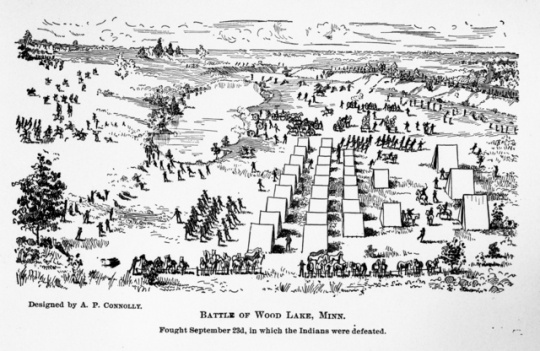
Battle of Wood Lake
Public domain
Holding Location
More Information
![Wood Lake. Battle Field. 43 Mls. from Fort Ridgley [i.e. Ridgely]](https://www3.mnhs.org/hubfs/Mnopedia%20Blogs/10385032.640x640.jpg)
Wood Lake. Battle Field. 43 Mls. from Fort Ridgley [i.e. Ridgely]
Public domain
Holding Location
More Information
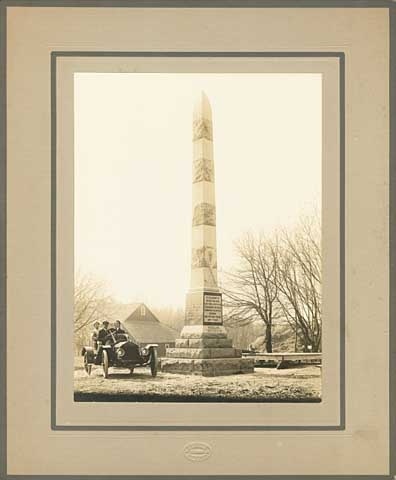
Woodlake Battlefield Monument
Public domain
Holding Location
More Information
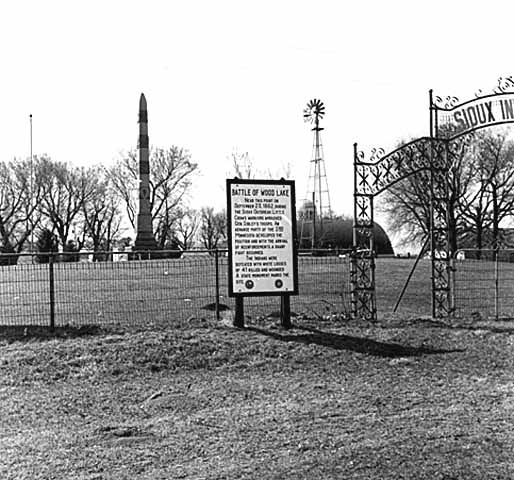
Wood Lake Battle Monument on site of the battle, west of Highway 67 between Echo and Granite Falls.
Holding Location
More Information
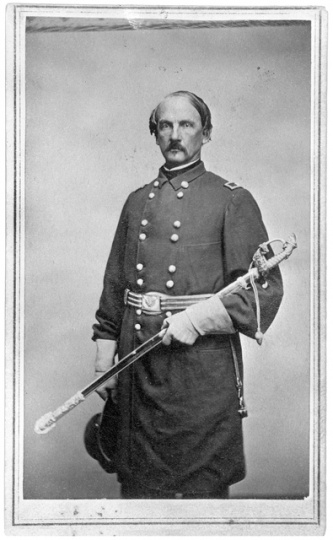
Henry H. Sibley
Public domain
Holding Location
More Information
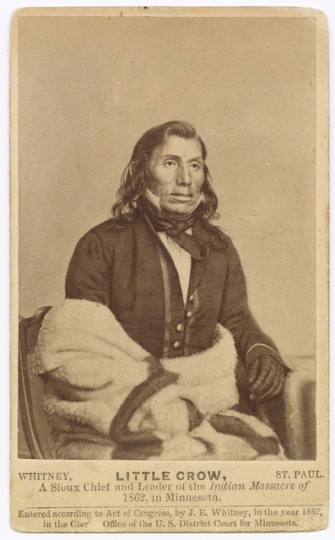
Ta Oyate Duta (His Red Nation, also known as Little Crow)
Holding Location
More Information
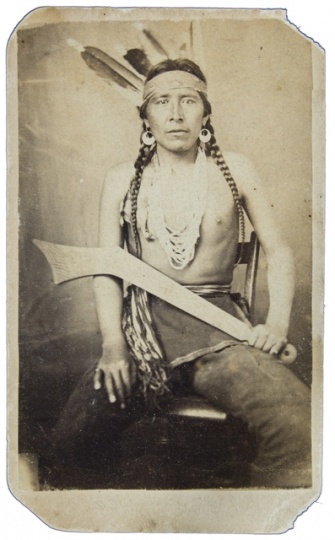
Wambditanka (Big Eagle)
Public domain
Holding Location
More Information
Related Articles
Turning Point
Colonel Henry Sibley's soldiers surprise the Dakota fighters, who are waiting to ambush Sibley's troops, on the morning of September 23, 1862. The ensuing battle leads to the defeat of the Dakota forces.
Chronology
August 17, 1862
September 2, 1862
September 19, 1862
September 23, 1862
December 26, 1862
Bibliography
Anderson, Gary Clayton. Little Crow: Spokesman for the Sioux. St. Paul: Minnesota Historical Society Press, 1986.
Anderson, Gary Clayton and Alan R. Woolworth, eds. Through Dakota Eyes-Narrative Accounts of the Minnesota Indian War of 1862. St. Paul: Minnesota Historical Society Press, 1988.
Carley, Kenneth. The Dakota War of 1862. St. Paul: Minnesota Historical Society Press, 2001.
Schultz, Duane. Over the Earth I Come: The Great Sioux Uprising of 1862. New York: St. Martin's Press, 1992.
Related Resources
Primary
M582
Dakota Conflict of 1862 Manuscripts Collections, 1862–1962
Manuscript Collection, Minnesota Historical Society, St. Paul
http://www2.mnhs.org/library/findaids/01166.xml
Description: This microfilm compilation includes letter, reports and diaries dealing with the U.S.-Dakota War. The compilation includes four reels dealing with the Dakota War. Reel One contains the hand-written reminiscences of Ezra Chapin, detailing his regiment's activities during the Battle of Wood Lake. The collection also includes the report of the commission established by the Minnesota Legislature to locate the Wood Lake battlefield. This report includes a description of the 1862 battle.
Secondary
Dahlin, Curtis A. Minnesota State Monuments to the Dakota Uprising. Roseville, MN: Curtis A. Dahlin, 2010.
———. The Dakota Uprising-A Pictorial History. Edina: Beaver's Pond Press, 2009
Lawrence, Elden. The Peace Seekers: The Indian Christians and the Dakota Conflict. Sioux Falls: Pine Hill Press, 2005.
Gilman, Rhoda. Henry Hastings Sibley-Divided Heart. St. Paul: Minnesota Historical Society Press, 2004.
Swain, Gwenyth. Little Crow: Leader of the Dakota. St. Paul: Minnesota Historical Society Press, 2004.
Wingerd, Mary Lethert. North Country: The Making of Minnesota. Minneapolis: University of Minnesota Press, 2010.
Web
Minnesota Historical Society. Minnesota Tragedy: U.S.-Dakota War of 1862
http://www.usdakotawar.org
http://www.usdakotawar.org/interactive-timeline
Minnesota Historical Society. Research Guides, U.S.-Dakota War of 1862
http://libguides.mnhs.org/war1862
Wood Lake Battlefield Preservation Association.
http://woodlakebattlefield.com



![Wood Lake. Battle Field. 43 Mls. from Fort Ridgley [i.e. Ridgely]](https://www3.mnhs.org/hs-fs/hubfs/Mnopedia%20Blogs/10385032.640x640.jpg?width=200&height=200&name=10385032.640x640.jpg)




